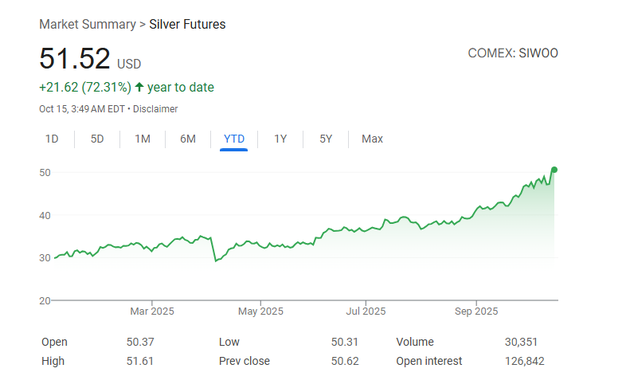Silver has surged to a historic high, recently breaking the $53 per ounce mark, fueled by what analysts describe as an epic short squeeze and unprecedented market dislocation. The metal's year-to-date gain of nearly 72% has significantly outperformed gold's 60.2% rise, defying its nickname, "the poor man's gold."
This explosive rally is marked by three extraordinary market phenomena.
Astronomical Silver Lease Rates
The cost of borrowing physical silver in the London market has dramatically spiked, reflecting a severe physical supply shortage. The annualized one-month lease rate for silver soared from around 6% to an astonishing 35% within the month, marking levels rarely seen. Since 2010, this rate had mostly remained below 5%.
This soaring borrowing cost puts immense pressure on short-sellers—those who sold silver they do not possess—by substantially increasing their costs for rolling over or settling their contracts.
London Spot Premium Triggers Trans-Atlantic Arbitrage
A major pricing anomaly has emerged, with the London spot price for silver exceeding the New York futures price by a rare margin of over $3 per ounce. This "basis" (spot minus futures price) has only surpassed this level a few times since 1975, often tied to significant market events like the Hunt brothers' cornering attempt in 1979-1980.
This massive price difference has opened up a significant arbitrage opportunity. Concerns over London's liquidity have prompted some traders to book expensive air freight for shipping physical silver bars across the Atlantic from New York to London—a costly method typically reserved for gold—to capitalize on the premium.
Silver's Outperformance: "Poor Man's Gold" No More
Silver's 72% year-to-date surge, which saw it break its 1980 historic peak of $49.45/oz, has dwarfed gold's 60.2% gain. This mirrors historical trends during major gold bull markets, such as 1976-1980 and 2008-2011, where silver's price increase significantly outstripped that of gold.

Driving Factors: A Perfect Storm of Scarcity
The convergence of these "three wonders" is a result of multiple, mutually reinforcing factors creating an acute shortage in the London market:
Depleting London Inventories: Concerns over potential U.S. tariffs on "critical minerals" (a list that includes silver) in the wake of the Trump administration's policies, as well as a subsequent "great migration" of physical silver to the U.S. earlier in the year, have drastically reduced London's available stock.
ETF Demand: The world's largest silver ETF, iShares Silver Trust (SLV), has seen its holdings surge this year. A large portion of London's vault inventory is now locked up as collateral for these ETFs. According to data, the amount of freely circulating silver in London has plummeted by 75% since mid-2019, falling to just about 200 million ounces.
Tightening Supply: Strong investment demand, increased industrial usage (especially in green technologies), and specific seasonal demand (like from India for the Diwali festival) are further straining the limited supply of deliverable metal.
The Question of a Short Squeeze
While analysts like Wang Yanqing of CITIC Futures believe a replay of the historic, large-scale manipulation seen with the Hunt brothers or the LME Nickel Squeeze in 2022 is unlikely due to stricter market regulations, the current environment presents opportunities for large institutions to potentially profit by amplifying the existing market trends.
The dramatic spike in lease rates and the high London premium are classic indicators of a short squeeze scenario, where short sellers are forced to cover their positions amidst a scarcity of physical metal, driving prices even higher.
The current arbitrage opportunity, though enticing, is complicated by the high silver lease rates and the time-consuming logistics of trans-oceanic shipping. Experts suggest that as these carry trades are executed—moving physical silver from New York to London—the price discrepancy should eventually narrow back toward historical norms.


 川公网安备 51019002001991号
川公网安备 51019002001991号





